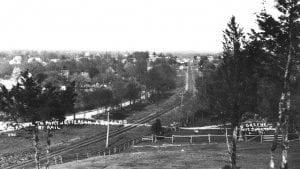Public officials of all levels of government, business and civic leaders, and community members gathered Monday, Jan. 9, before a derelict building at the Lawrence Aviation Superfund site in Port Jefferson Station.
Once a dumping ground for toxic waste, policymakers are now plotting a course of action for this 126-acre property. After taking decades to rid the site of harmful contaminants, officials and community groups are working toward an ambitious proposal to convert the site into a multipurpose community hub, accommodating a solar farm, a railyard and open space for local residents.
U.S. Senate Majority Leader Chuck Schumer (D-NY) called the press conference to announce the injection of $450,000 in federal funds secured through the recent omnibus budget. This money will be used to help demolish the remaining buildings at the property.
“We’re here today to showcase one of the final puzzle pieces needed to demo 14 dangerous buildings here,” Schumer said. “I am here today to say that the train that is on this journey is ready to leave the station.”
The Senate majority leader added that these funds would advance three community goals. “One, a railroad-use project to help the LIRR with logistics; industrial redevelopment of a 5-megawatt solar farm,” and lastly, add 50 construction jobs to the local economy.

Suffolk County Executive Steve Bellone (D) described the considerable intergovernmental coordination and logistical obstacles to get to this stage.
“This project, as reflected by all of the people that have come together and all the levels of government, is critically important to the community,” he said.
Town of Brookhaven Supervisor Ed Romaine (R) discussed the long and arduous road to revitalizing the site and the decades that have passed as this community blight lay barren.
“These buildings have been condemned for over 25 years,” he said. “This has been a Superfund site for almost 25 years. Finally, we will see these buildings come down.”
Former New York State Assemblyman Steve Englebright (D-Setauket) also attended the press event. During his time in Albany, he championed the site’s conversion for environmental and community purposes.
“We have a plan that will enhance our community and create new jobs,” he said. “This property stood out as a place in peril of a potentially bad decision,” adding, “Instead, we have a very thoughtful plan.”
Englebright, a geologist by trade, also touched upon the environmental impacts that redevelopment will offer through these plans. He said local harbors, groundwater and surface waters would benefit as this dark episode in local history concludes.

“The harbor, which is the beginning of our town, has been poisoned by the solvents that were poured into the ground here,” the former assemblyman said. “That is a thing of the past because of the federal involvement with the Superfund cleanup.”
He added, “All the levels of government are working together here, which is a beautiful thing. It’s a model for what government should be able to do all the time.”
Jen Dzvonar, president of the Port Jefferson Station/Terryville Chamber of Commerce, also offered her perspective. She said public improvements such as these indirectly support and promote local businesses.
“Any improvement in Port Jefferson Station is major,” she said. “By getting the blight away from the area, we will increase businesses. A solar farm is coming. They’re creating 50 construction jobs. It just heightens Port Jefferson Station and the desire to come here.”
Representing the Village of Port Jefferson were Mayor Margot Garant and Deputy Mayor Kathianne Snaden. Both stressed the importance of this undertaking, conveying their support for neighboring Port Jefferson Station in its community aspirations.
Garant viewed the plans as an opportunity to improve the Port Jefferson Branch line of the Long Island Rail Road. “We’re really in support of this because of the MTA portion of it,” she said. “To clean up this site, to put it back to public use, to not have the county paying taxes on it, is good for everybody.”
For Snaden, the project will bolster the village’s neighbors, representing a vital regional investment. “I think it’s great,” she said. “It’s a cleanup of the site. It’s knocking down these falling buildings, adding to the betterment of the entire community and the region at large.”
Schumer said the next step would be to ensure that the U.S. Department of Housing and Urban Development expedites these funds, ensuring the prompt demolition of the buildings and swift redevelopment of the site.



















